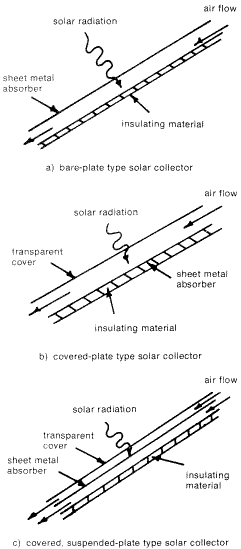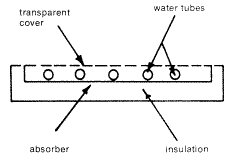Concentrating collectors collect the sun's rays from a relatively large area and focus them on a point. If you ever used a magnifying glass to focus the sun's rays to start a fire, you have used a concentrating collector. In the field of solar collection, parabolic (bowl-shaped) mirrorsare generally used instead of a magnifying glass or Fresnel lens. The effect is the same.
Parabolic mirrors can create extremely high temperatures (over 2,000 degrees). These can be used to generate steam, which can be used directly or to power electrical generators. They can also provide high-grade heat (90C and up) required to run absorption chillers.
A dish which tracks the sun in two dimensions can reach hotter temperatures than a parabolic trough which tracks only one dimension (and focuses sunlight onto a straight line, usually a pipe containing water, molten salt, or oil).
Concentrating collectors require precisely constructed surfaces and a tracking device to "follow" the sun across the sky during the day. Because of this, they are relatively expensive and need much maintenance.
Flat plate collectors
There are many different designs for flat plate collectors, but they all have two basic characteristics: (1) a flat plate to absorb energy from the sun and (2) a circulating medium to pick heat up from the plate and transport it to storage or the point of use. The two media most commonly used for absorbing and transferring the heat are air and water.
Air collectors
An air collector can be as simple as a bare sheet of metal, like a metal roof, painted a dull black to absorb as much energy as possible, with air blown underneath in a duct of some type.

Typical air solar collectors.
A second type, called a covered plate collector, uses a cover plate of glass, plastic or fiberglass with air circulated between the cover and the absorber plate. The cover acts as a barrier between the wind and absorber and reduces heat loss from the absorber plate to the outside air due to wind blowing across the surface and taking away some of the heat.
A third type, called a covered, suspended plate, has air circulated both above and below the absorber plate. This provides twice as much surface area for heat transfer from the absorber plate to the air. The top cover reduces convection loss from the wind across the surface, as it does in the covered plate type.
In most collectors, insulation for the back of the collector is necessary to reduce the conduction heat loss through the rear of the collector. A cover also reduces radiation heat loss from the front of the collector.
Water collectors
A water collector has the same basic components as an air collector: an absorber plate and a transfer medium. The difference is in how the medium is passed over the absorber.
The basic water collector consists of an absorber plate, generally with water tubes attached, a cover, and insulation behind the absorber plate. Heat from the absorber plate is removed by the water circulating in the tubes. Another type of water collector has no water tubes. The water simply flows down over the absorber in a sheet or in an open channel if the absorber is corrugated. The type with tubes is generally more efficient, but the open channel type generally costs less.

A water solar collector.
Freezing in the winter can be a problem with water collectors. You can get around that problem by draining the collector when it is not in use or by adding antifreeze to the water. Other problems with water solar collectors include leaks in the plumbing and metal corrosion.
Source: http://muextension.missouri.edu/xplor/agguides/agengin/g01971.htm
faq@solarmirror.com